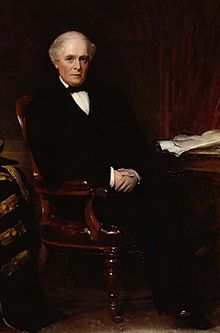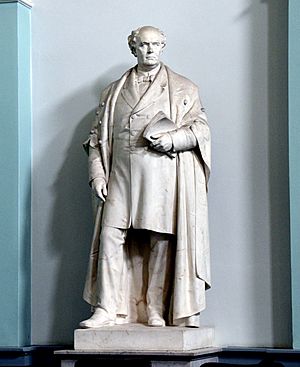Dominic Corrigan facts for kids
Quick facts for kids
Sir Dominic Corrigan, Bt
|
|
|---|---|
 |
|
| Born | 2 December 1802 Thomas Street, Dublin, Ireland
|
| Died | 1 February 1880 (aged 77) Merrion Square, Dublin
|
| Alma mater | St. Patrick's College, Maynooth, University of Edinburgh |
| Known for | aortic valve insufficiency, Corrigan's pulse |
| Scientific career | |
| Fields | Medicine |
| Institutions | Sick Poor Institute, Dublin, Jervis Street Hospital, House of Industry Hospitals |
Sir Dominic John Corrigan (born December 2, 1802 – died February 1, 1880) was a very important Irish doctor. He is well-known for his discoveries about heart disease. One specific heart problem, where a main heart valve doesn't close properly, causes a special "collapsing" pulse. This pulse is named Corrigan's pulse after him.
Contents
Early Life and Learning
Born in Dublin
Dominic Corrigan was born in Thomas Street, Dublin, Ireland. His father sold tools for farming.
School and Medical Training
He went to St. Patrick's College, Maynooth. At that time, the college had a part for regular students, not just those studying to become priests. A doctor who worked there inspired young Dominic to study medicine.
He spent several years learning from a local doctor, Edward Talbot O'Kelly. Later, Corrigan studied medicine in Dublin. He then moved to the Edinburgh Medical School in Scotland. He earned his medical degree in August 1825.
Medical Career and Public Service
Starting His Practice
After finishing his studies, Corrigan returned to Dublin in 1825. He opened his own medical practice. As more people came to him for help, his practice grew. He moved to bigger offices in 1832 and again in 1837.
Helping the Community
Besides his private practice, Dr. Corrigan worked in many public hospitals. He was a doctor at Maynooth College, the Sick Poor Institute, and the Charitable Infirmary Jervis Street. He also worked at the House of Industry Hospitals.
He often treated some of Dublin's poorest people. This work helped him become an expert in diseases of the heart and lungs. He gave many talks and wrote a lot about these topics. People knew him as a very dedicated doctor, especially during the terrible Great Famine in Ireland.
Becoming a Politician
In 1870, Corrigan was chosen to be a Member of Parliament (MP) for Dublin. He was part of the Liberal Party. In parliament, he worked hard to improve education in Ireland. He also pushed for the early release of some prisoners called Fenians.
He decided not to run for re-election in 1874. Some of his ideas, like supporting temperance (avoiding alcohol) and closing pubs on Sundays, were not popular with everyone.
Awards and Recognition
Royal Appointments
In 1847, Dr. Corrigan was named the Queen's physician in Ireland. Two years later, he received an honorary medical degree from Trinity College.
Leading Medical Societies
In 1846, some people tried to stop Corrigan from becoming a fellow of the Royal College of Physicians of Ireland. But he found a way around this. In 1855, he took the college's entrance exam, just like new doctors. He became a fellow in 1856.
In 1859, he was elected president of the college. He was the first Catholic to hold this important position. He was re-elected president four times, which was very unusual. There is a statue of him at the college, made by John Henry Foley.
He also led other important groups, like the Royal Zoological Society of Dublin and the Dublin Pathological Society.
Later Honors
From the 1840s, he was a member of the senate (a governing body) of the Queen's University. In 1871, he became its vice-chancellor. In 1866, he was given the title of baronet. This was partly to reward him for his many years of service as a Commissioner of Education.
He was also a member of the board for Glasnevin Cemetery. A famous French doctor, Armand Trousseau, even suggested that aortic heart disease should be called "Corrigan's disease."
Today, a heart ward at Beaumont Hospital, Dublin is named The Corrigan Ward in his honor. Part of his family's special crest is also on the Beaumont Hospital crest.
Family Life and Passing
His Family
In 1827, Dominic Corrigan married Joanna Woodlock. She was the daughter of a rich merchant and the sister of Bishop Dr. Bartholomew Woodlock. They had six children: three girls and three boys.
Sadly, Corrigan's oldest son, Captain John Joseph Corrigan, died at age 35 in 1866. He is buried in Australia. Dominic Corrigan's grandson later inherited his baronet title.
His Death
Sir Dominic Corrigan passed away at Merrion Square, Dublin, on February 1, 1880. He had suffered a stroke the previous December. He is buried in the crypt of St. Andrews Church in Dublin.
See also
- Pathology
- List of pathologists


